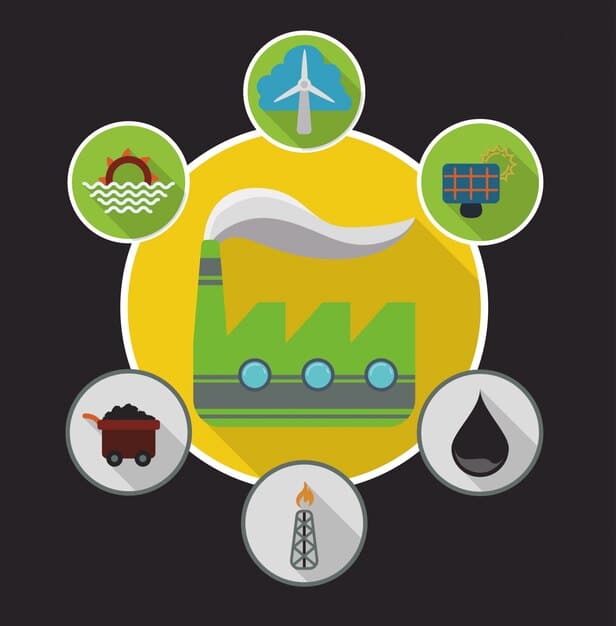EPA Methane Rule Impact: US Oil & Gas Outlook 2025

The updated EPA regulations on methane emissions, set to impact US oil and gas companies in 2025, will necessitate significant investments in leak detection and repair technologies, enhanced monitoring, and infrastructure upgrades to comply with stricter emission standards, potentially increasing operational costs and reshaping industry practices.
The US Environmental Protection Agency’s (EPA) updated methane emission regulations are poised to significantly reshape the operational landscape for US oil and gas companies by 2025. The How Will the Updated EPA Regulations on Methane Emissions Impact US Oil and Gas Companies in 2025? is a multifaceted question, impacting everything from daily operations to long-term investments and strategic planning.
Understanding the EPA’s Updated Methane Regulations
The EPA’s updated methane regulations represent a crucial step in the US effort to combat climate change. These regulations build upon existing rules and introduce new requirements aimed at reducing methane emissions from the oil and gas sector. Understanding the scope and specifics of these regulations is essential for any company operating in this sector.
Key Components of the Updated Regulations
The new rules target various sources of methane emissions throughout the oil and gas supply chain, from production to processing and transmission. Some key provisions include:
- Enhanced leak detection and repair (LDAR) programs: Companies will be required to implement more frequent and thorough leak detection surveys using advanced technologies.
- Stricter standards for new and modified sources: New or modified oil and gas facilities will be subject to stringent emission limits and must utilize best available control technologies.
- Emissions standards for existing sources: The EPA is establishing emissions guidelines for existing oil and gas operations as well, prompting states to develop implementation plans.
The EPA’s regulatory actions are grounded in the Clean Air Act and reflect the Biden administration’s commitment to reducing greenhouse gas emissions. The updated regulations also seek to align US methane reduction efforts with international agreements, such as the Global Methane Pledge.

Assessing the Impact on US Oil and Gas Companies
The impact of the updated EPA regulations on US oil and gas companies will be significant, touching on various aspects of their operations. Compliance with the new rules will require substantial investments, operational adjustments, and a shift in corporate culture.
The key challenges companies will face include:
- Increased operational costs: Implementing enhanced LDAR programs, upgrading equipment, and complying with monitoring and reporting requirements will lead to higher operating expenses.
- Technological challenges: Adopting and deploying advanced leak detection and emissions control technologies may pose technical hurdles, particularly for smaller operators.
- Supply chain constraints: Demand for specialized equipment and services could strain supply chains, potentially delaying compliance efforts.
While the regulations present challenges, they also offer opportunities for innovation and efficiency improvements. By embracing new technologies and adopting best practices, companies can mitigate the cost impact and enhance their environmental performance.
Preparing for Compliance: Strategies and Technologies
To successfully navigate the updated EPA regulations, oil and gas companies must proactively adopt strategies and technologies that ensure compliance. A comprehensive approach encompassing infrastructure upgrades, advanced monitoring, and workforce training is essential.
Key Strategies for Compliance
- Conducting comprehensive emissions inventories: Identifying all sources of methane emissions within their operations is a crucial first step for companies.
- Developing detailed compliance plans: These plans should outline specific actions, timelines, and resource allocations for meeting regulatory requirements.
- Engaging with regulators and stakeholders: Open communication and collaboration with the EPA, state agencies, and other stakeholders can help clarify requirements and facilitate compliance.
Furthermore, companies need to invest in workforce training programs to ensure that employees have the knowledge and skills to operate equipment safely, detect leaks effectively, and comply with regulatory procedures.

The Role of Technology in Methane Emissions Reduction
Technology will play a pivotal role in enabling oil and gas companies to meet the updated EPA regulations. Advanced leak detection systems, emissions monitoring technologies, and infrastructure upgrades are essential for achieving substantial methane reductions.
Promising Technologies for Methane Control
Several innovative technologies offer significant potential for mitigating methane emissions:
- Satellite-based methane detection: Satellites equipped with hyperspectral imagers can detect methane plumes from space, allowing for wide-area monitoring and identification of super-emitters.
- Drone-based leak detection: Drones equipped with methane sensors can conduct aerial surveys of oil and gas facilities, providing high-resolution leak detection at a fraction of the cost of traditional methods.
- Artificial intelligence (AI) and machine learning (ML): AI and ML algorithms can analyze sensor data to predict potential leaks, optimize equipment performance, and enhance emissions monitoring accuracy.
By embracing these technological advancements, companies can improve their environmental performance and gain a competitive edge in the evolving energy landscape.
Economic Implications and Market Dynamics
The updated EPA regulations will have significant economic implications for US oil and gas companies and the broader energy market. While compliance costs are a concern, the regulations also create opportunities for innovation and market differentiation.
The potential economic effects include:
- Shift in investment priorities: Companies will need to allocate more capital to emissions reduction projects, potentially diverting resources from other investments.
- Increased natural gas prices: Compliance costs could lead to higher natural gas prices, affecting consumers and industries that rely on natural gas as a primary energy source.
- Growth of the methane mitigation industry: The demand for leak detection services, emissions control technologies, and related expertise will drive growth in the methane mitigation industry.
However, companies that proactively address methane emissions and demonstrate environmental leadership may be able to attract investors, secure financing, and differentiate themselves in the marketplace.
The Future of Methane Regulations and Industry Practices
Looking ahead, methane regulations are likely to become even more stringent, reflecting growing concerns about climate change and the need for deeper emissions reductions. Oil and gas companies must adapt to this evolving regulatory landscape and proactively adopt sustainable practices.
Potential Future Developments
- Expansion of regulatory coverage: Future regulations could extend to smaller oil and gas operations and other sources of methane emissions, such as abandoned wells.
- Integration with carbon pricing mechanisms: Policies that put a price on carbon emissions could incentivize further methane reductions and create new revenue streams for companies that capture and utilize methane.
- Increased international collaboration: Greater cooperation among countries on methane reduction efforts could lead to more harmonized regulations and technology standards.
By embracing sustainable practices and investing in methane mitigation technologies, oil and gas companies can not only comply with regulations but also contribute to a cleaner environment and a more sustainable energy future.
| Key Point | Brief Description |
|---|---|
| 🚧 Updated EPA Regulations | Stricter rules to reduce methane emissions from oil and gas companies, effective in 2025. |
| 💰 Financial Impact | Companies face increased costs for compliance, technology upgrades, and monitoring systems. |
| 🛰️ Technological Advancements | Companies need to invest in advanced tech like satellites, drones, and AI for leak detection and repair. |
| 🌱 Future Regulations | Expect more stringent rules, potential carbon pricing, and greater international collaboration on emissions. |
Frequently Asked Questions (FAQ)
▼
The main goals are to reduce methane emissions from the US oil and gas sector, align with international climate agreements, and promote the use of advanced leak detection and repair technologies.
▼
Companies will need to invest in optical gas imaging cameras, satellite-based methane detection systems, drone-based leak detection, and AI-powered data analytics for emissions monitoring.
▼
Smaller operators may face significant challenges due to the high costs of compliance with the new regulations, potentially leading to consolidation within the industry.
▼
States are responsible for developing and implementing plans to meet the EPA’s emission guidelines for existing oil and gas operations, tailoring their approaches to local conditions.
▼
Reducing methane emissions can help slow the pace of climate change, improve air quality, and enhance the long-term sustainability of the oil and gas industry.
Conclusion
The updated EPA regulations on methane emissions represent a significant turning point for the US oil and gas industry. While the path to compliance may be challenging, it also presents opportunities for innovation, efficiency gains, and a more sustainable energy future.





